Detailing Understandable Rights Packages - Editorial Covers
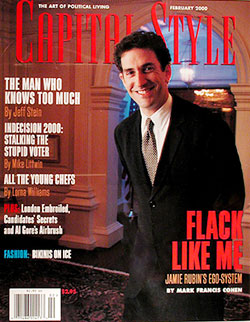 Consider this - You're called to shoot a magazine cover. Your marketing paid off, and you have fees and expenses that fit the clients' budget, and are fair to you.
Consider this - You're called to shoot a magazine cover. Your marketing paid off, and you have fees and expenses that fit the clients' budget, and are fair to you.
How do you define your rights package so you and the client understand it. Simple. Speak the same language. Use PLUS. (Check it out - it's free for you as a photographer to use!)
Here are a few ways you could define your contract:
In their "PLUS Packs" category, they have a package of rights for the cover. It is:
Periodical Cover - One Issue (PPCO)So, your license might read:
Use on the cover of a magazine, newspaper or journal. Applies to a single printed issue of a periodical. Includes distribution of same issue on publisher's website. Allows reproduction of cover for promotional purposes.
You define the following:
Duration, PLUS Region, Region Constraints, End User, Product or Service Name, License Start Date
Produce one portrait of {subject} on September 1, 2007, for ZYQ Magazine cover. Rights granted are: Periodical Cover - One Issue (PLUS PACK:PPCO), beginning October 1, 2007 in the United States, for ZYQ Magazine.
In addition to that information being on the front of your contract, under a field like "Description of Assignment and Rights Licensed", you would want to include that text into the metadata of the image you are sending them. While future metadata templates and fields will make this process easier, for now, It could well look like this (click to see larger):
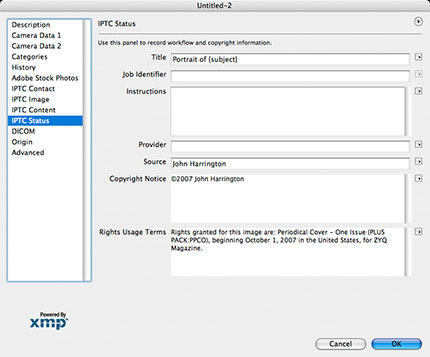
Here's a screen grab of my contract for an assignment I shot last week:
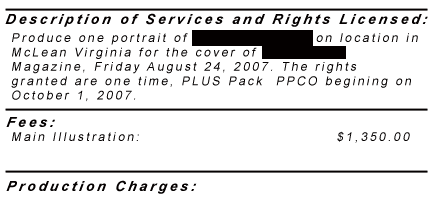
In the rare case that your publication is akin to People, and People En Espagnol, your license should then include a language specification, and could then read:
Produce one portrait of {subject} on September 1, 2007, for ZYQ Magazine cover. Rights granted are: Periodical Cover - One Issue (PLUS PACK:PPCO), beginning October 1, 2007 in the United States, English language only, for ZYQ Magazine.Suppose though, that you're assignment is for the inside of the magazine? PLUS PACK PPIO works for you:
Periodical Interior - One Issue (PPIO)So, your license could then read:
Use on an interior page of a magazine, newspaper or journal. Applies to a single printed issue of a periodical. Includes distribution of same issue on publisher's website. Allows reproduction of page for promotional purposes.
You define the following:
Duration, PLUS Region, Region Constraints, End User, Product or Service Name, License Start Date
Produce one portrait of {subject} on September 1, 2007, for ZYQ Magazine interior story. Rights granted are: Periodical Interior - One Issue (PLUS PACK:PPIO), beginning October 1, 2007 in the United States, for ZYQ Magazine.What if you're client's not familiar with the PLUS glossary? You could include the cross-industry accepted definition as well:
Produce one portrait of {subject} on September 1, 2007, for ZYQ Magazine cover. Rights granted are: Periodical Cover - One Issue (PLUS PACK:PPCO), beginning October 1, 2007 in the United States, for ZYQ Magazine. PLUS Pack PPCO is defined as: "Use on the cover of a magazine, newspaper or journal. Applies to a single printed issue of a periodical. Includes distribution of same issue on publisher's website. Allows reproduction of cover for promotional purposes." For more information, visit USPLUS.com.This additional information, whether this license, or the one below, could make it more undertandable.
Suppose though, that your client is insisting that reprint rights (i.e. being able to reprint the cover story to sell to the subject of the story for their own promotional purposes) be included? After you've determined the additional fee that should apply to this extension of the rights being granted, then try then "PLUS (Rights Ready) Packs". There, you'll find:
Editorial Front Cover (PREC)So, your assignment description on your contract would read:
Use on the front cover of a magazine, newspaper, book or other printed material not intended for commercial or promotional purposes. Use applies to a single issue or edition and all reprints or printed versions of the original use. Image may only be used on the front cover of the publication.
you then define:
Duration, PLUS Region, Region Constraints, End User, Product or Service Name, License Start Date
Produce one portrait of {subject} on September 1, 2007, for ZYQ Magazine cover. Rights granted are: Editorial Front Cover (PLUS PACK:PREC), beginning October 1, 2007 in the United States, for ZYQ Magazine.Or, if the definition needed to be included as we did above:
Produce one portrait of {subject} on September 1, 2007, for ZYQ Magazine cover. Rights granted are: Editorial Front Cover (PLUS PACK:PREC), beginning October 1, 2007 in the United States, for ZYQ Magazine. PLUS Pack PREC is defined as: "Use on the front cover of a magazine, newspaper, book or other printed material not intended for commercial or promotional purposes. Use applies to a single issue or edition and all reprints or printed versions of the original use. Image may only be used on the front cover of the publication." For more information, visit USPLUS.com.
Here's how it looked for an assignment from two months ago for a smaller circulation trade publication:
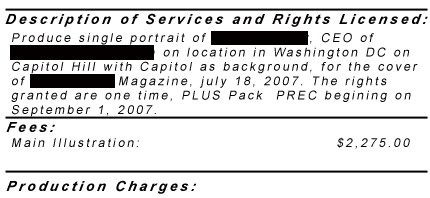
By being specific about your rights packages, it makes it so much clearer for everyone to understand, and fewer clients will be demanding "all rights" deals, when you've given them what they need, and they pay for those needs.
Please post your comments by clicking the link below. If you've got questions, please pose them in our Photo Business Forum Flickr Group Discussion Threads.
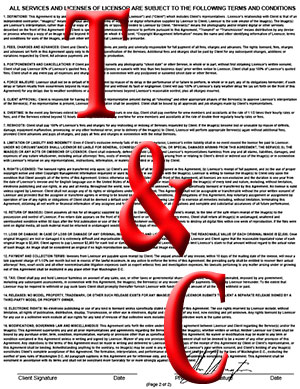 Term #2: "2. FEES, CHARGES AND ADVANCES: Client and Client’s representatives are jointly and severally responsible for full payment of all fees, charges and advances. The rights licensed, fees, charges and advances set forth in this Agreement apply only to the original specification of the Services. Additional fees and charges shall be paid by Client for any subsequent changes, additions or variations requested by Client. All advance payments are due prior to production."
Term #2: "2. FEES, CHARGES AND ADVANCES: Client and Client’s representatives are jointly and severally responsible for full payment of all fees, charges and advances. The rights licensed, fees, charges and advances set forth in this Agreement apply only to the original specification of the Services. Additional fees and charges shall be paid by Client for any subsequent changes, additions or variations requested by Client. All advance payments are due prior to production." 